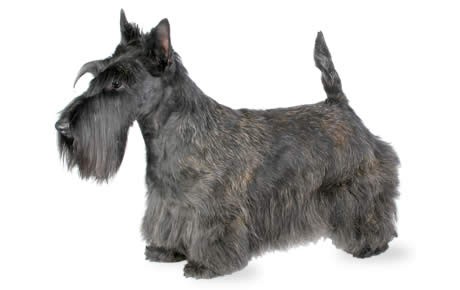Scottish Terrier Breed Guide

Breed Group:
Terrier Dogs
Get 30% off
Join our Newsletter
Sign Up Today
Scottish Terrier Background Info & History
The Scottish Terrier breed has an old and unclear history. Even though much of their beginnings are undocumented, researchers are still able to conclude that the Scottish Terrier is one of the oldest breeds in Scotland, and is the original foundation for all terrier breeds. Starting in the 1430’s, the Scottish Terrier was seen in different Scottish Novels and books, playing a main role in everyday life.
During the 17th century, James I of England sent several Scottish Terriers to France as a present to the monarch. Once the king of France fell in love with this breed, the Scottish Terrier quickly gained popularity over the next three centuries through all of France. Throughout history, the Scottish Terrier was used for their hunting skills, excelling at catching vermins and other small animals.
Throughout the 1800’s, terriers were split into two separate groups, the Dandie Dinmont and the Skye Terriers. During this time period, they were also introduced to the United States by a man named John Naylor. This breed spiked in popularity after World War II across America. They even made their way to the white house as two different President’s canine companions.
Scottish Terrier Temperament & Personality
The Scottish Terrier personality is confident, fearless, and feisty. They also have a tendency to be quite independent, and will sometimes play favorites with the members of the family. They are skeptical of strangers or other dogs, and it takes awhile for them to warm up to someone. This makes them a great watchdog for the entire family. Once they warm up to you, they will be a loyal companion for life. Just like with other terrier breeds, Scotties can be very sensitive at times. Make sure to never scold or punish them, especially during training. They are not a needy breed, which means they can be left alone for a few hours. When they are still in their early puppy years, they are extremely playful and spunky.
Just like with other terrier breeds, Scotties can be very sensitive at times. Make sure to never scold or punish them, especially during training. They are not a needy breed, which means they can be left alone for a few hours. When they are still in their early puppy years, they are extremely playful and spunky. However, as they age, they become more independent and reserved. Scotties are a great dog for single-member families or families with a few members.
Scottish Terrier Trainability
The Scottish Terrier likes to challenge their owners while training. Even though they are an intelligent breed, they can be very independent, making them have a mind of their own. If a Scottish Terrier doesn’t feel like training that day, chance are, they will just go and do what they want. This breed is best with an owner who has a lot of experience in training a challenging breed.
For additional support, try enrolling them in a puppy training course. When training a Scottish Terrier, make sure to start the process as early on as possible. Just like with any other breed, training during puppyhood establishes good behavior at a young age, which will stick with them throughout their life. Make sure to socialize them with unfamiliar people, dogs, sounds, and experiences. This will make them feel more comfortable in everyday situations.
Scottish Terrier Exercise Requirements
Even though the Scottish Terrier is an energetic breed, they only require a moderate level of physical activity each day. You should walk your dog 20-40 minutes daily to keep them healthy and happy. This breed is not made for endurance, so try to stay away from long runs or hikes. Let your Scotties exert their energy by chasing the kids around the yard or playing tug-of-war with a family member.
Scottish Terriers have no problem adjusting to apartment life or large estates. Keep in mind that they should never be locked in the house all day. A bored Scottie will find any way to entertain themselves, and that may include digging up your flowers in the backyard or chewing through your living room sofa.
Scottish Terrier Lifespan
The Scottish Terrier life expectancy is 12-15 years.
Popularity of Scottish Terriers
Even to this day, the Scottish Terrier has struggled to gain popularity, especially compared to their close terrier cousins. Throughout history, this breed was very popular in Scotland and eventually made their way to the rest of Europe during the 17th and 18th centuries. It wasn’t until after WWII that this breed became a familiar breed in the United States. Today, the American Kennel Club has ranked the Scottish Terrier 58th most popular dog breed in the United States.
Feeding Recommendations for Scottish Terriers
A Scottish Terrier should be fed 1- 1 ½ cups of high-quality food a day, split into two separate servings. The amount of food is dependent on their activity level, metabolism, age, and size. Make sure to consult with your veterinarian for a complete feeding regimen catered to your unique dog. Smaller breeders can easily become overweight or obese, so feeding them the proper amount can be critical for their overall health.
The quality of food you provide them is also an important factor. Look for all natural and organic products that contain no soy, preservatives, or fillers. Also, make sure to have fresh water available at all times. Change the water at least once a day to prevent bacteria from growing in their dish.
Grooming a Scottish Terrier
The Scottish Terrier is characterized by a shaggy beard, legs, lower body, and eyebrows. The iconic appearance of the Scottie needs professional grooming at least three times a year if it is kept long. For a shorter coat, the fur should be trimmed every 8-12 weeks. Luckily for owners, their thick double coat has minimal shedding.
Professionals suggest brushing at least once a week to keep their coat shiny and healthy. Use a soft-bristled brush to rid any dead hair or dirt from their coat. Only bathe a Scottie every couple of months or as needed. Their wiry coat has a specific texture, and over bathing will cause it to soften.
Be sure to also check their ears at least once a week for wax build-up or infection. Use a veterinarian-approved solution and a cotton ball to gently clean their ears. The last important step to grooming a Scottish Terrier is to brush their teeth at least once a week. This will prevent tartar and bacteria from building up.
Are Scottish Terriers Good With Kids?
Scottish Terriers are great for children. Some people have even nicknamed this breed “the nanny” because of their protective qualities. Loud and rowdy toddlers may be too much for a Scottie to handle. Older children who know how to handle and care for a dog would be a better fit for this breed.
Toddlers tend to be rough when playing with smaller dogs, which can make a Scottie snappy or aggressive. The best way to make your dog comfortable around children is to have them raised with them at a young age. Socialization is critical for a Scottie to be well behaved in a family setting.
Scottish Terrier Health Problems
Just like with any other breed, the Scottish Terrier is prone to several different health complications. Below is a list of the most common health issues that Scottish Terriers suffer from.
Cataracts: This eye disease happens when the lens of the eye becomes white or opaque. In some cases, cataracts are brought on with old age, however, they can also be hereditary and passed on through birth. They also vary in severity on a case by case basis. In serious conditions, cataracts can cause blindness and require surgery.
Progressive retinal atrophy: PRA is the degeneration of the photoreceptors in the eye. In early onset, this causes difficulty seeing at night, and eventually leads to total blindness. Unfortunately there is no cure for PRA, however, dogs are known to adapt very quickly when losing their vision.
Scottie cramp: This is a harmless disorder that often shows in stressed or overworked terriers. Scottie cramp occurs when a dog’s front legs move back and forth or have an arch in their spine. Scottie cramp does not require treatment and should go away on its own.
Von Willebrand’s disease: Von Willebrand’s disease occurs when blood cannot clot properly. Symptoms include bleeding gums, excessive bleeding after surgery, and nose bleeds.
Craniomandibular Osteopathy: This disorder occurs when the bones of the skull do not form properly and become enlarged. Once this happens, a puppy’s jaw will become swollen and they will not be able to open their mouth properly. In severe cases, craniomandibular osteopathy can cause problems with eating or complete immobility of the jaw.
More Resources
National Breed Website: Scottish Terrier Club of America
Scottish Terrier Rescue: Scottie Kingdom Rescue, Inc.
Health Issues Associated with this Breed:
- Anxiety
- Craniomandibular Osteopathy
- Inflammation
- Pain
- Patellar Luxation
- Separation Anxiety
- von Willebrand's Disease (vWD)





